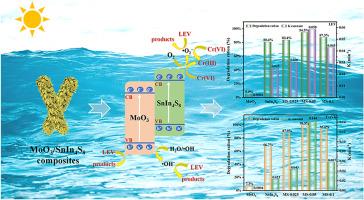Efficient levofloxacin degradation and Cr(VI) reduction by S-scheme MoO3@SnIn4S8 heterostructure
IF 8.2
2区 材料科学
Q1 MATERIALS SCIENCE, MULTIDISCIPLINARY
引用次数: 0
Abstract
The increasing discharge of pharmaceuticals and heavy metals into aquatic environments poses serious ecological threats, creating an urgent need for effective wastewater treatment technologies. In this study, a MoO3@SnIn4S8 heterojunction photocatalyst was successfully produced via a facile straightforward hydro/solvothermal technique for photocatalytic degradation of both levofloxacin (LEV) antibiotics and hexavalent chromium (Cr(VI)). The optimized MS-0.05 heterojunction exhibited exceptional photocatalytic performance, achieving 94.5 % degradation of LEV (40 mg/L) within 50 min using only 0.2 g/L catalyst, significantly outperforming pristine MoO3 (5 %) and SnIn4S8 (80.4 %). For Cr(VI) reduction, the heterojunction at a dosage of 0.5 g/L accomplished complete removal of 20 mg/L Cr(VI) within 50 min, demonstrating remarkable improvements over the individual components (MoO3: 7.4 %; SnIn4S8: 66.7 %). Comprehensive characterization and theoretical analysis revealed an S-scheme charge transfer pathway governing the photocatalytic process. These findings demonstrate the great potential of MoO3@SnIn4S8 heterojunction as an efficient dual-functional photocatalyst for removing both pharmaceutical contaminants and heavy metals in wastewater treatment applications.

s -方案MoO3@SnIn4S8异质结构高效降解左氧氟沙星及还原Cr(VI)
越来越多的药物和重金属排放到水生环境造成了严重的生态威胁,迫切需要有效的废水处理技术。在本研究中,通过简单直接的水/溶剂热技术成功制备了MoO3@SnIn4S8异质结光催化剂,用于光催化降解左氧氟沙星(LEV)抗生素和六价铬(Cr(VI))。优化后的MS-0.05异质结具有优异的光催化性能,仅使用0.2 g/L的催化剂,在50 min内对40 mg/L的LEV降解率达到94.5%,明显优于原始的MoO3(5%)和SnIn4S8(80.4%)。对于Cr(VI)的还原,异质结在0.5 g/L的剂量下可以在50分钟内完全去除20 mg/L的Cr(VI),比单个组分(MoO3: 7.4%; SnIn4S8: 66.7%)表现出显著的改善。综合表征和理论分析揭示了控制光催化过程的S-scheme电荷转移途径。这些发现证明了MoO3@SnIn4S8异质结作为一种高效的双功能光催化剂在废水处理应用中去除药物污染物和重金属的巨大潜力。
本文章由计算机程序翻译,如有差异,请以英文原文为准。
求助全文
约1分钟内获得全文
求助全文
来源期刊

Materials Today Nano
Multiple-
CiteScore
11.30
自引率
3.90%
发文量
130
审稿时长
31 days
期刊介绍:
Materials Today Nano is a multidisciplinary journal dedicated to nanoscience and nanotechnology. The journal aims to showcase the latest advances in nanoscience and provide a platform for discussing new concepts and applications. With rigorous peer review, rapid decisions, and high visibility, Materials Today Nano offers authors the opportunity to publish comprehensive articles, short communications, and reviews on a wide range of topics in nanoscience. The editors welcome comprehensive articles, short communications and reviews on topics including but not limited to:
Nanoscale synthesis and assembly
Nanoscale characterization
Nanoscale fabrication
Nanoelectronics and molecular electronics
Nanomedicine
Nanomechanics
Nanosensors
Nanophotonics
Nanocomposites
 求助内容:
求助内容: 应助结果提醒方式:
应助结果提醒方式:


